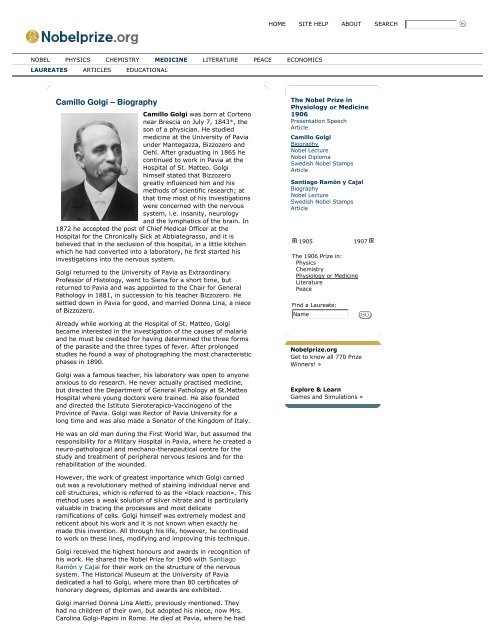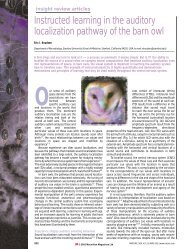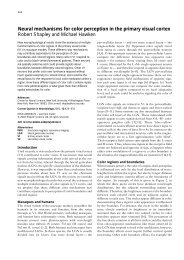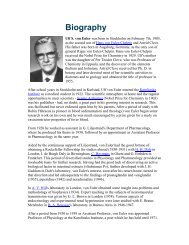Camillo Golgi - Biography - BACK
Camillo Golgi - Biography - BACK
Camillo Golgi - Biography - BACK
You also want an ePaper? Increase the reach of your titles
YUMPU automatically turns print PDFs into web optimized ePapers that Google loves.
HOME SITE HELP ABOUT SEARCH<br />
NOBEL PHYSICS CHEMISTRY MEDICINE LITERATURE PEACE ECONOMICS<br />
LAUREATES ARTICLES EDUCATIONAL<br />
<strong>Camillo</strong> <strong>Golgi</strong> – <strong>Biography</strong><br />
<strong>Camillo</strong> <strong>Golgi</strong> was born at Corteno<br />
near Brescia on July 7, 1843*, the<br />
son of a physician. He studied<br />
medicine at the University of Pavia<br />
under Mantegazza, Bizzozero and<br />
Oehl. After graduating in 1865 he<br />
continued to work in Pavia at the<br />
Hospital of St. Matteo. <strong>Golgi</strong><br />
himself stated that Bizzozero<br />
greatly influenced him and his<br />
methods of scientific research; at<br />
that time most of his investigations<br />
were concerned with the nervous<br />
system, i.e. insanity, neurology<br />
and the lymphatics of the brain. In<br />
1872 he accepted the post of Chief Medical Officer at the<br />
Hospital for the Chronically Sick at Abbiategrasso, and it is<br />
believed that in the seclusion of this hospital, in a little kitchen<br />
which he had converted into a laboratory, he first started his<br />
investigations into the nervous system.<br />
<strong>Golgi</strong> returned to the University of Pavia as Extraordinary<br />
Professor of Histology, went to Siena for a short time, but<br />
returned to Pavia and was appointed to the Chair for General<br />
Pathology in 1881, in succession to his teacher Bizzozero. He<br />
settled down in Pavia for good, and married Donna Lina, a niece<br />
of Bizzozero.<br />
Already while working at the Hospital of St. Matteo, <strong>Golgi</strong><br />
became interested in the investigation of the causes of malaria<br />
and he must be credited for having determined the three forms<br />
of the parasite and the three types of fever. After prolonged<br />
studies he found a way of photographing the most characteristic<br />
phases in 1890.<br />
<strong>Golgi</strong> was a famous teacher, his laboratory was open to anyone<br />
anxious to do research. He never actually practised medicine,<br />
but directed the Department of General Pathology at St.Matteo<br />
Hospital where young doctors were trained. He also founded<br />
and directed the Istituto Sieroterapico-Vaccinogeno of the<br />
Province of Pavia. <strong>Golgi</strong> was Rector of Pavia University for a<br />
long time and was also made a Senator of the Kingdom of Italy.<br />
The Nobel Prize in<br />
Physiology or Medicine<br />
1906<br />
Presentation Speech<br />
Article<br />
<strong>Camillo</strong> <strong>Golgi</strong><br />
<strong>Biography</strong><br />
Nobel Lecture<br />
Nobel Diploma<br />
Swedish Nobel Stamps<br />
Article<br />
Santiago Ramón y Cajal<br />
<strong>Biography</strong><br />
Nobel Lecture<br />
Swedish Nobel Stamps<br />
Article<br />
1905 1907<br />
The 1906 Prize in:<br />
Physics<br />
Chemistry<br />
Physiology or Medicine<br />
Literature<br />
Peace<br />
Find a Laureate:<br />
Name<br />
Nobelprize.org<br />
Get to know all 770 Prize<br />
Winners! »<br />
Explore & Learn<br />
Games and Simulations »<br />
He was an old man during the First World War, but assumed the<br />
responsibility for a Military Hospital in Pavia, where he created a<br />
neuro-pathological and mechano-therapeutical centre for the<br />
study and treatment of peripheral nervous lesions and for the<br />
rehabilitation of the wounded.<br />
However, the work of greatest importance which <strong>Golgi</strong> carried<br />
out was a revolutionary method of staining individual nerve and<br />
cell structures, which is referred to as the «black reaction». This<br />
method uses a weak solution of silver nitrate and is particularly<br />
valuable in tracing the processes and most delicate<br />
ramifications of cells. <strong>Golgi</strong> himself was extremely modest and<br />
reticent about his work and it is not known when exactly he<br />
made this invention. All through his life, however, he continued<br />
to work on these lines, modifying and improving this technique.<br />
<strong>Golgi</strong> received the highest honours and awards in recognition of<br />
his work. He shared the Nobel Prize for 1906 with Santiago<br />
Ramón y Cajal for their work on the structure of the nervous<br />
system. The Historical Museum at the University of Pavia<br />
dedicated a hall to <strong>Golgi</strong>, where more than 80 certificates of<br />
honorary degrees, diplomas and awards are exhibited.<br />
<strong>Golgi</strong> married Donna Lina Aletti, previously mentioned. They<br />
had no children of their own, but adopted his niece, now Mrs.<br />
Carolina <strong>Golgi</strong>-Papini in Rome. He died at Pavia, where he had
lived all his life, on January 21, 1926.<br />
From Nobel Lectures, Physiology or Medicine 1901-1921, Elsevier<br />
Publishing Company, Amsterdam, 1967<br />
This autobiography/biography was written at the time of the award and<br />
later published in the book series Les Prix Nobel/Nobel Lectures. The<br />
information is sometimes updated with an addendum submitted by the<br />
Laureate. To cite this document, always state the source as shown<br />
above.<br />
* Other sources state 1844.<br />
SITE FEED<strong>BACK</strong> CONTACT TELL A FRIEND PRINTER-FRIENDLY PAGE <strong>BACK</strong> TO TOP<br />
Last modified March 10, 2005<br />
Copyright © 2005 The Nobel Foundation





